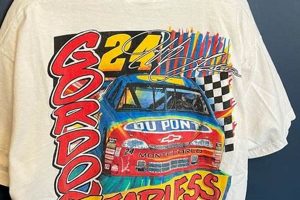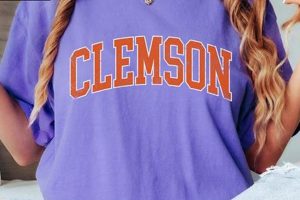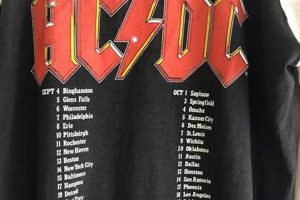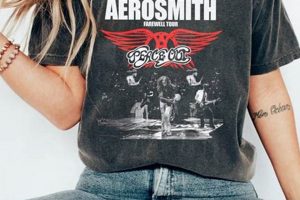Apparel displaying designs and imagery associated with the early era of off-road motorcycle racing represents a specific category within the broader realm of vintage clothing. These items often feature faded graphics, retro fonts, and illustrations of classic motorcycles and racers, evoking a sense of nostalgia for the sport’s formative years. An example would be a cotton garment showcasing a prominent rider from the 1970s astride a Maico or Husqvarna.
The appeal of these garments lies in their connection to the history and culture of motocross. They serve as tangible links to a period characterized by raw competition, simpler technology, and a distinct aesthetic. Furthermore, these items can hold significant value for collectors and enthusiasts, representing a tangible piece of the sport’s heritage. Their popularity also stems from a broader trend toward vintage fashion and a desire for unique, individualistic expression.
The following sections will delve into the aspects of identifying authentic examples, explore key design elements, and discuss factors influencing the value of these sought-after collectibles.
Tips on Assessing Collectible Motocross Garments
Evaluating garments linked to the pioneering years of motocross requires careful attention to detail. Several factors influence authenticity and overall worth. The following guidelines aid in making informed assessments.
Tip 1: Examine the Fabric. Original garments from the 1970s and 1980s were commonly constructed from single-stitch cotton. Inspecting the seams for this characteristic is a crucial first step. Later reproductions often utilize double-stitched seams.
Tip 2: Scrutinize the Graphics. The printing quality of vintage pieces reflects the technologies available at the time. Signs of fading, cracking, and slight imperfections in the graphic are indicative of age and potential authenticity. Exceptionally crisp, flawless prints should raise suspicion.
Tip 3: Research Manufacturer Labels. Identifying the original manufacturer can provide valuable clues. Research brands popular during the relevant era, such as Hanes, Screen Stars, or Sportswear. Compare the label design and font with examples from that period.
Tip 4: Evaluate the Design’s Historical Accuracy. Garments that authentically represent the motocross scene of a particular era feature specific motorcycle brands, rider names, and event logos. Verify that the design aligns with known historical records and imagery.
Tip 5: Consider Garment Condition. While some wear and tear is expected in vintage clothing, excessive damage can significantly reduce value. Examine the garment for holes, stains, and irreparable damage. Light fading and minor imperfections are often acceptable, even desirable, adding to the vintage aesthetic.
Tip 6: Assess Rarity and Collectibility. Certain designs or event-specific items hold greater value due to their limited availability. Designs featuring prominent riders or commemorating significant races may command higher prices.
By carefully examining fabric, graphics, labels, design accuracy, and overall condition, informed evaluations of sought-after motocross collectibles become attainable. Accurate assessment protects against misrepresentation and contributes to responsible collecting practices.
The subsequent section will explore the enduring appeal and cultural significance surrounding vintage motocross memorabilia.
1. Authenticity
Authenticity, in the context of apparel related to the early days of off-road motorcycle racing, signifies that the garment originated during the period it purports to represent and possesses the characteristics typical of that era. This determination directly influences value and collectibility. Demand hinges on verifying that an item genuinely reflects the materials, manufacturing techniques, and graphic design trends prevalent in motocross culture from the 1960s through the 1980s. Misrepresentation, whether intentional or unintentional, diminishes the item’s significance as a historical artifact.
The pursuit of authentic pieces necessitates careful examination of manufacturing details. For example, many genuine garments from the 1970s feature a single-stitch construction, a method less common in later reproductions. Similarly, identifying original manufacturer labels, such as those from Hanes or Screen Stars, strengthens the case for validity. The graphic design itself must align with the period. A print featuring a contemporary motorcycle model on a garment claiming to be from the 1970s would immediately raise doubts about its legitimacy. Discrepancies like these highlight the importance of thorough research and a keen eye for detail.
The connection between authenticity and collectibles is paramount. Recognizing the indicators of genuine vintage motocross items ensures responsible collecting and protects against potential fraud. Accurate assessment preserves the integrity of motocross history. Authenticity underpins the value and the cultural significance that collectors and enthusiasts attach to these articles.
2. Era-Specific Graphics
Era-specific graphics form a crucial link between a garment and its intended historical period, significantly influencing the item’s value and desirability within the realm of vintage motocross apparel. These graphics function as immediate visual cues, identifying the era of motocross the is meant to represent and contributing substantively to its perceived authenticity. The design elements incorporated within these graphics, including typography, color palettes, motorcycle models, and depictions of prominent riders, act as a visual fingerprint, connecting the apparel to a specific timeframe within the sport’s history. Without accurate graphics from the period, garments claiming to be vintage are reduced to mere reproductions, losing much of their collector appeal. For instance, a item that featured the two-stroke motorcycles and bright color schemes synonymous with the 1980s, provides a tangible visual reference to that decade, making it sought-after among enthusiasts.
The presence of era-specific graphics allows collectors and enthusiasts to establish a verifiable connection to motocross history. An example is the presence of brand logos, advertising particular brands from that period. Or the presence of a specific year in the design of that shirt that represents that year era. Furthermore, these designs often encapsulate the cultural atmosphere surrounding the sport at the time, reflecting trends in music, fashion, and overall societal attitudes. The ability to recognize and interpret these graphical cues enables enthusiasts to differentiate between genuine artifacts and modern interpretations, fostering a deeper appreciation for the sport’s evolution.
Consequently, understanding the role and significance of era-specific graphics is vital for anyone interested in collecting, preserving, or studying apparel related to vintage motocross. A commitment to detail when it comes to graphic elements contributes to the overall accuracy of vintage garments, protecting the garment from misrepresentation. Collectors and enthusiasts are contributing to the preservation of motocross history and culture in its most tangible form.
3. Fabric Composition
The material composition of garments associated with vintage motocross significantly affects their authenticity, durability, and value. Primarily, garments from the 1960s through the 1980s commonly employed 100% cotton. This selection offered a balance of breathability and affordability, critical for the active nature of the sport. The specific weave and weight of the cotton further influenced its suitability, with lighter weaves preferred for warm weather and heavier weights offering greater resistance to wear. The presence of synthetic fibers, while not entirely absent, was less prevalent in earlier examples; their appearance may suggest a later production date or a reproduction.
The type of fiber, thread construction, and any treatments applied to the fabric impact the garment’s aging process. Vintage cotton, for example, is prone to fading, shrinking, and developing a unique patina over time. This aging process contributes to the garment’s visual character and is considered desirable by many collectors, provided it does not compromise the fabric’s structural integrity. Conversely, synthetic blends exhibit differing aging characteristics, often showing less fading but potentially suffering from degradation or discoloration due to prolonged exposure to sunlight or washing. Careful analysis of the fabric’s texture, drape, and any signs of wear provides key insights into its age and potential authenticity.
Knowledge of textile manufacturing practices during the relevant eras helps collectors to accurately assess collectible motocross garments. Fabric composition impacts preservation efforts; vintage cotton demands specific cleaning and storage protocols to prevent damage. Accurate material identification ensures informed decisions regarding restoration or display, protecting the garment’s integrity and historical value.
4. Rarity Valuation
The scarcity of a particular garment within the landscape of vintage motocross apparel directly influences its monetary and collectable worth. Assessing the factors contributing to rarity is therefore a critical component of valuation within this niche market.
- Limited Production Runs
Garments produced in small quantities, often due to event-specific releases or collaborations, become inherently more valuable. For example, apparel created for a particular motocross race in the 1970s, with a limited print run for participants and staff, will command a higher price than mass-produced designs. The documentation of such limited releases, through period advertisements or event programs, further strengthens the valuation.
- Discontinued Designs
Styles or graphics that were only available for a short period contribute to scarcity. Designs featuring specific rider endorsements or team sponsorships that were terminated early result in a finite number of garments in circulation. The historical context surrounding the discontinuation, such as a rider’s retirement or a team’s disbandment, enhances the collectible appeal.
- Geographic Exclusivity
Garments sold only in specific regions or countries add to their rarity. Apparel distributed solely at motocross events in Europe, for example, will be less common in North America, increasing its value among collectors seeking complete sets or geographically diverse collections. Provenance documentation, such as purchase receipts or shipping labels, can authenticate geographic exclusivity.
- Exceptional Condition of Rare Examples
While rarity establishes a baseline value, the condition of a rare garment is a crucial multiplier. A limited-edition from the 1970s in pristine, unworn condition will be significantly more valuable than the same garment exhibiting substantial wear and tear. Preservation of original tags and labels further elevates the item’s worth. The confluence of rarity and exceptional condition represents the pinnacle of value within the vintage motocross market.
The interplay of these factors dictates the price point of desirable motocross collectibles. Understanding the nuances of limited production, discontinued designs, geographic exclusivity, and the condition of rare examples enables collectors to make informed acquisition decisions and appreciate the inherent value embedded within these tangible pieces of motocross history.
5. Condition Assessment
Evaluating the physical state of vintage motocross apparel is critical for determining its authenticity, value, and suitability for collection or wear. The presence and extent of damage, alterations, or wear patterns can significantly impact a garment’s desirability and historical significance. Thorough condition assessment protects both buyers and sellers, ensuring accurate representation and preventing misinterpretation of an item’s age and provenance.
- Fabric Integrity
The structural soundness of the textile is a primary concern. Examine for holes, tears, fraying, or weakened areas, particularly at seams and stress points. Minor imperfections may be acceptable, reflecting the garment’s age, but significant damage compromises its overall integrity and value. Stains, discoloration, and excessive fading also detract from the item’s condition. Distinguish between age-related patina, which can enhance vintage appeal, and detrimental damage that compromises the fabric.
- Graphic Preservation
The condition of printed graphics, logos, and lettering is a key indicator of wear and authenticity. Assess for cracking, peeling, fading, or distortion of the design elements. Minor cracking can be typical of vintage prints, particularly those applied with screen-printing techniques. However, extensive degradation detracts from the item’s aesthetic and historical value. Compare the graphic’s appearance to known examples from the period to verify its accuracy and assess any signs of alteration or replacement.
- Seam and Stitching Analysis
Carefully inspect the seams and stitching for signs of unraveling, repairs, or alterations. Original stitching patterns and techniques can provide clues to the garment’s age and authenticity. Inconsistent or poorly executed repairs detract from its value. Examine the garment’s overall structure and assess whether the seams are intact and capable of withstanding wear. A thorough analysis of the seams contributes to a comprehensive understanding of the garment’s construction and condition.
- Original Tag and Label Presence
The presence and legibility of original tags and labels provide valuable information about the manufacturer, fabric composition, and care instructions. Examine the tag for signs of damage or removal, which can indicate alteration or misrepresentation. Compare the tag’s design and font to known examples from the period to verify its authenticity. Intact, legible tags and labels enhance the garment’s provenance and contribute to its overall value.
Condition assessment is not merely an evaluation of flaws; it is an exercise in historical interpretation. Understanding the types of wear and damage that commonly affect vintage garments allows collectors and enthusiasts to appreciate the unique character and history embodied within each piece. A thorough assessment enhances the appreciation and ensures responsible stewardship of these tangible artifacts.
6. Cultural Significance
Apparel from the early era of motocross racing transcends mere functional clothing, embodying a tangible connection to the sport’s history and cultural milieu. Garments displaying logos, rider names, and motorcycle brands serve as visible symbols of a distinct subculture characterized by individualism, mechanical ingenuity, and a pursuit of adrenaline-fueled competition. The cultural significance emanates from the association with pivotal moments, iconic figures, and the aesthetic sensibilities that defined motocross during its formative years. The wearing of such an item, therefore, is more than just an act of adornment; it signifies an affiliation with this history and an appreciation for its enduring legacy. For instance, a t-shirt featuring the image of Bob Hannah, a dominant racer of the 1970s, carries a cultural weight beyond its material composition, representing an admiration for his skill and the era he defined.
The ongoing demand for this type of memorabilia reflects a broader societal trend toward embracing vintage aesthetics and connecting with the past. Motocross items provide a physical link to a time when the sport was less commercialized, and the emphasis was on raw talent and mechanical innovation. The graphics often displayed on these garments bold colors, stylized fonts, and action-oriented imagery capture the spirit of the era, evoking a sense of nostalgia among those who experienced it firsthand and intriguing those who seek to understand its appeal. These garments are often seen at vintage motocross events and classic motorcycle shows, reinforcing their role as emblems of a shared history and passion. The preservation and collection of such apparel, therefore, contributes to the safeguarding of motocross’s cultural heritage.
Understanding the cultural weight attached to vintage motocross apparel is essential for collectors, historians, and enthusiasts alike. Appreciating the significance extends beyond mere monetary valuation, fostering a deeper appreciation for the sport’s evolution and its impact on popular culture. The continued interest in such garments underscores their enduring relevance as symbols of a bygone era, serving as a reminder of the dedication, innovation, and sheer thrill that characterized motocross in its earliest and perhaps purest form. Challenges remain in authenticating garments and preserving them for future generations, but the effort is justified by the cultural capital these pieces represent.
Frequently Asked Questions Regarding Vintage Motocross Garments
The following section addresses common inquiries and misconceptions concerning apparel associated with the early history of motocross. The information provided aims to clarify key aspects for collectors, enthusiasts, and those seeking to understand the market for such items.
Question 1: How can one distinguish between a genuine vintage item and a modern reproduction?
Assessment requires careful examination of several factors, including fabric composition, stitching techniques, printing methods, and the presence of original manufacturer labels. Genuine garments from the 1970s and 1980s typically feature single-stitch construction and are printed on thinner cotton fabrics. Modern reproductions often employ double-stitched seams and utilize thicker, more durable cotton.
Question 2: What design elements are characteristic of apparel from the formative years of motocross?
Key design features include era-specific motorcycle models (e.g., Maico, Husqvarna), logos of prominent racing teams and sponsors, and stylized typography reflecting the aesthetic trends of the period. Graphics often incorporate vibrant colors and bold, action-oriented imagery.
Question 3: How does garment condition influence value?
Condition plays a significant role in determining the worth. While some degree of wear is expected in vintage items, excessive damage, such as holes, tears, or significant staining, can substantially decrease value. Garments in excellent condition, with minimal wear and intact graphics, command premium prices.
Question 4: Which brands are considered most desirable among collectors?
Garments produced by well-known sportswear manufacturers of the era, such as Hanes, Screen Stars, and Sportswear, are generally sought after. In addition, apparel associated with specific racing teams or events may hold added appeal.
Question 5: How does rarity impact the market?
Garments produced in limited quantities, whether due to event-specific releases or short production runs, are often highly valued. Examples tied to significant races or featuring popular riders also command higher prices due to their scarcity.
Question 6: Are there reliable resources for verifying the authenticity of garments?
Online forums and communities dedicated to vintage motocross can provide valuable information and insights. Consulting with experienced collectors and researching historical records, such as old magazines and race programs, can aid in authentication efforts.
In conclusion, the assessment of vintage motocross apparel involves a multifaceted approach, considering factors such as construction, design, condition, brand, rarity, and historical context.
The subsequent section explores the enduring popularity and cultural influence of vintage motocross memorabilia in contemporary society.
Conclusion
The preceding analysis has explored the multifaceted aspects of vintage motocross t shirts. It has examined the criteria for assessing authenticity, the significance of era-specific graphics and fabric composition, the factors influencing rarity valuation, the importance of condition assessment, and the enduring cultural significance these garments hold. The analysis emphasizes the intersection of historical documentation, material analysis, and cultural understanding required for the accurate appraisal and appreciation of these collectible items.
The continued interest in vintage motocross t shirts reflects a sustained fascination with the sport’s heritage and its impact on popular culture. Preservation efforts and informed collecting practices are essential to ensure that these tangible artifacts continue to represent a vital chapter in motocross history for future generations. Maintaining diligent research and careful evaluation will safeguard the integrity and historical accuracy associated with these garments.







